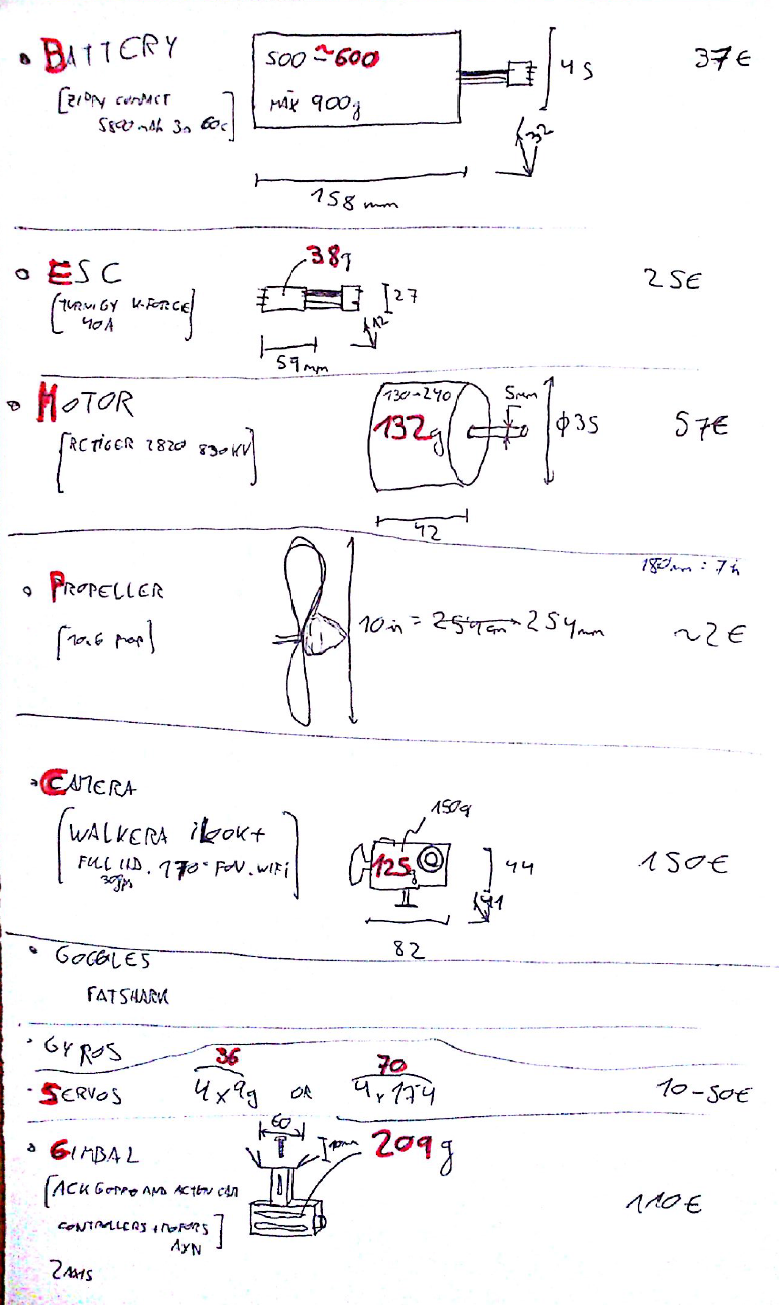These are some scanned sheets from the process of decisions making and the iteration process:
Example of similar components approach. Payload estimation.
Rules determining the class of components
Weight estimation
On one hand, there is the empty weight, the weight of
the structure without its components. This empty weight is not the same as
defined for manned aircraft, where it takes into account all the electronic
components and all the other necessary things to fly except the fuel, crew and
passengers.
This weight will be defined by the mass of the fuselage,
wings, horizontal and vertical stabilizers and the landing gear. The mass is
defined by the volume of the aircraft and the density of the material chosen.
Similar models without camera, gimbal, smaller battery and
motor and made of foam weight from 1500 to 2500 kg. It is expected that just changing
to carbon fiber increases the weight significantly (carbon fiber density = 1.55
g/cm3, EPO density = 0.8 g/cm3).
The payload definition for this unmanned aircraft is
the group of electronic components.
First estimation range (specs, weights, dimensions and prices)
First estimation:
• Battery (Zippy Compact 5800mAh 3s 60C) – 500 to 600g (max. 900g) – 158x45x32 – 37€
• ESC (Turnigy K-Force 40A) – 38g – 59x27x12 – 25€
• Motor (RC Tiger 2820 830kV) – 132g (130 to 240g) – 35x42 – 57€
• Propeller (10x6in) – 254mm – 2€
• Camera (Walkera iLook+ FullHD 170fov WiFi) – 125g – 82x44x41 – 150€
• Servos – 4x9g = 36g or 4x17.4g = 70g – 10 or 50€
• Gimbal (2 axis ACK GoPro and Action Cam, controllers + motors AXN) – 209g – 110€
Payload: from 1040g to 1192g (max. 1622g)
Let’s say, with the similar planes, the empty weight is 2000g, minus the motor, ESC, battery and servos (~474g) is 1500g approximately, plus the carbon fiber weight, climbs to 2500-3000. If the previous components are added it reaches a take-off weight of 3500 to 4300g (max. 4600g).
If the volume of the plane is mostly made out of foam, the weight of the structure shouldn’t be over 2000 g.
Taking different components, the payload might be over 1000 g. So the final weight would be almost 3000 g.
Weights scheme
Now the website ecalc.ch is the next tool to find which components combined together will make the plane fly wihout performance issues.
After several iterations and finding the correct data of the components that are manufactured and can be bought online nowadays, these are two suitable options:
The third option is better because of its shorter propeller and lighter motor
The performance is good enough, there are no issues with the thrust to weight ratio and the motor cooling is optimal.
Final choice
This final selection has a perfect compatibility between its components. All the power system is from the manufacturer Turnigy, which is one of the leading companies in the RC world. The servos are not from this trademark but it doesn’t state a problem (although they can be chosen with the same specs labelled Turnigy too), and Hextronic has very good reviews too for servomotors.
The high capacity battery gives a flight time of 20 minutes, which can be extended if good use of gliding is carried out.
The Electronic Speed Controller has a Battery Eliminator Circuit installed so the same battery can power the receiver and servos.
Gyroscopes PCB has the same connections as all standard receiver cables. It is just a bridge between the receiver and the servos.
The only missing data is the structure price. If it’s foam it will be cheap but if carbon fiber is added the price might increase a bit more than expected.
The rest of the manufacturing cost for the mission is completed by the systems on the ground, whose weight is not taken into consideration.
The final flying model is expected to cost less than 1000 €,
all included. A study of the sale price for a mass production plane will be
made further on.
Extra scans
Random notes in Spanish
Modified first draft. Completed and uncompleted tasks in post-it schedule.
Drafts for camera, landing gear and tail configuration











No comments:
Post a Comment